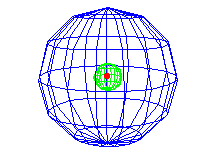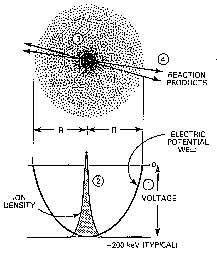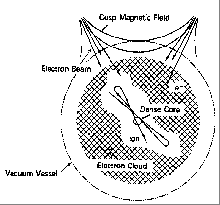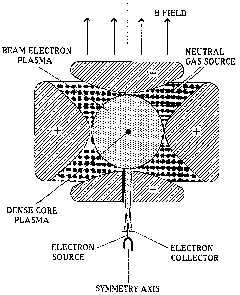Brief Overview of Inertial-Electrostatic-Confinement Fusion
John F. Santarius
Fusion Technology Institute
|
Historically, most fusion research has focused on energy production in two basic configurations: magnetic confinement (magnetic fusion energy or MFE), and inertial confinement (inertial fusion energy or IFE). Each of these may lead eventually to a viable fusion reactor, yet they tend to be large, complicated, and expensive. This generates many physics and engineering difficulties, so the time frame for their development remains uncertain. The present note describes a fundamentally different fusion concept based on electrostatic focusing of ions into a dense core. Generically, such systems are called inertial-electrostatic confinement (IEC) fusion systems. In the 1950's, research was done on one form of IEC, purely electrostatic confinement, in which a voltage difference on concentric grids focuses charged particles [1]. Ions accelerate down the electrostatic potential in spherical geometry, and convergence at the origin gives high density [1]. Figure 1 shows the basic geometry, and the key physics elements appear in Figure 2. Another purely electrostatic approach is to inject a sufficiently high electron current into a magnetic trap to form a virtual cathode, which then traps a high density of ions in the resulting electrostatic potential well [2]. This approach must find an operating regime that reduces transverse momentum and instabilities to a level allowing sufficient focusing for fusion power production. A third approach utilizes a Penning Trap to confine the electrons [3] |
 Figure 1: Grids plus energetic
plasma core of the simplest IEC configuration.
Figure 1: Grids plus energetic
plasma core of the simplest IEC configuration.
 Figure 2: Electrostatic potential and ion density radial profiles in an IEC device [2]. |
|
The gridded IEC approach possesses the significant advantage that ions can be accelerated to high voltages (tens of keV) with relative ease. Even small IEC devices appear able to produce high-energy (MeV) neutrons and protons or electromagnetic radiation at levels useful for medical, environmental, and industrial applications. This should greatly facilitate IEC fusion development. Examples of applications that University of Wisconsin personnel have begun investigating include [4-6]:
Inertial-electrostatic confinement devices possess another key feature: they are excellent configurations for burning the second-generation advanced fusion fuels D3He, and potentially could even burn the third-generation fuels, 3He-3He and p-11. Possible applications include not only electricity production, but also high-energy (~15 MeV) proton production for positron production and other uses. In IEC devices, the main energy losses should be due to transport of electrons or ions (direct loss of fusion products) and to bremsstrahlung radiation. An important aspect of the IEC concept is that much of the relevant physics can be tested in moderately sized experiments, and the University of Wisconsin [7-9], among others [10, 11], presently conducts such research. A small, purely electrostatic-confinement experiment with spherical grids accelerating the ions, is being used at UW to investigate core convergence and optimize production of neutrons and protons. |
Recently, a concept called the Polywell was invented [2]. Its operating principle is magnetic confinement of electrons and electrostatic confinement of ions in a geometry of nearly spherical symmetry. The basic physics of the Polywelltm is illustrated in Fig. 3. The magnetic-field cusps (only two of many symmetrically located cusps are shown) are formed by currents flowing in conductors placed at the edges of various polyhedral configurations. 
Figure 3: Physics concepts for the Polywelltm concept [12]. Injected electrons form a cloud throughout the interior of the sphere, resulting in a negative electrostatic potential well, as shown in Fig. 3. Ions are injected at low energy or created by neutral gas ionization at the outer edge of the electron cloud. These ions fall down the potential hill and converge on the origin of the sphere, giving a small, spherical core of high density (see Fig. 2). For a sufficiently deep potential well, steady-state fusion power can be generated in this core. Preliminary investigations of the Polywelltm concept have led to the conclusion that it can be a viable fusion reactor [2, 12-14], although several questions remain [15, 16].In the Penning trap approach [11], combined electric and magnetic fields confine electrons, which create the electrostatic potential well required to accelerate ions into a dense core. The basic concept appears in Figure 4. The possibility of achieving high core density using radio-frequency waves at the edge to create radial plasma oscillations is under investigation [17]. |

Figure 4: Basic configuration of a Penning-trap IEC device. Polywelltm reactors are intrinsically steady-state, driven devices, and the main energy-loss mechanism should be electron transport out the cusps. This mechanism, however, is expected to be fundamentally different from the loss of electrons out of magnetic-mirror or multipole cusps [12], because the Polywelltm will operate at b~1 (b?plasma pressure/magnetic-field pressure). This is predicted to greatly reduce plasma transport losses in cusp geometry [12]. Both the physics and engineering of IEC fusion reactors would be profoundly different from that of either magnetic or inertial fusion reactors. Because fusion-product energies are much higher than the electrostatic potential well depth, fusion products are not confined and fusion ash does not accumulate. An intriguing possibility for IEC reactors is converting much of the energy of the escaping fusion products directly to electricity using spherically symmetric grids of constant voltage, as shown in Figure 5. |

Figure 5: An IEC reactor configured for direct electrostatic conversion of fusion-product energy to electricity [2]. Key physics and engineering issues that remain to be resolved for inertial-electrostatic-confinement fusion devices are:
If these issues get resolved favorably, the engineering of IEC reactors appears manageable, and IEC reactors should be very attractive with regard to safety, environment, and economics. Even if the realization of economic electricity production takes considerable development time, near-term IEC devices appear able to produce levels of high-energy neutrons and protons that have useful industrial and medical applications. |
|
References 1. R. Hirsch, "Inertial-Electrostatic Confinement of Ionized Fusion Gases," Journal of Applied Physics 38, 4522 (1967). 2. R.W. Bussard, "Some Physics Considerations of Magnetic Inertial-Electrostatic Confinement: A New Concept for Spherical Converging-flow Fusion," Fusion Technology 19, 273 (1991). 3. D.C. Barnes, R.A. Nebel, and L. Turner, "Production and Application of Dense Penning Trap Plasmas," Physics of Fluids B 5, 3651 (1993). 4. G.L. Kulcinski, "Near Term Commercial Opportunities from Long Range Fusion Research," Fusion Technology 30, 411 (1996). 5. G.L. Kulcinski and J.F. Santarius, "Reducing the Barriers to Fusion Electric Power," Journal of Fusion Energy 17, 17 (1997). 6. G.L. Kulcinski, "Non-Electric Applications of Fusion Energy--An Important Precursor to Commercial Electric Power," Fusion Technology, Part 2 34, 477 (1998). 7. T.A. Thorson, R.D. Durst, R.J. Fonck, and L.P. Wainwright, "Convergence, Electrostatic potential, and desity measurements in a spherically convergent ion focus," Physics of Plasmas 4, 4 (1997). 8. R.P. Ashley, G.L. Kulcinski, J.F. Santarius, S.K. Murali, and G. Piefer, "D-3He Fusion in an Inertial Electrostatic Confinement Device," 18th IEEE Symposium on Fusion Engineering (IEEE, Albuquerque, New Mexico, 1999), p. 37.
|
9. R.P. Ashley, G.L. Kulcinski, J.F. Santarius, S.K. Murali, G. Piefer, et al., "Steady-State D-3He Proton Production in an IEC Fusion Device," Fusion Technology, Part 2 39, 546 (2001). 10. G.H. Miley, J. DeMora, J. Stubbers, I.V. Tzonev, R.A. Anderl, et al., "Optimization of IEC Grid Design for Maximum Neutron Production," Fusion Technology 30, 1315 (1996). 11. D.C. Barnes, T.B. Mitchell, and M.M. Schauer, "Beyond the Brillouin Limit with the Penning Fusion Experiment," Physics of Plasmas 4, 1745 (1997). 12. N.A. Krall, "The Polywell: A Sperically Convergent Ion Focus Concept," Fusion Technology 22, 42 (1992). 13. M. Rosenberg and N.A. Krall, "The effect of collisions in maintaining a non-Maxwellian plasma distribution in a spherically convergent ion focus," Phys. Fluids B 4, 1788 (1992).14. S.K. Wong and N.A. Krall, "Potential well formation by injection of electrons with various energy distributions into a sphere or a slab," Physics of Fluids B 4, 4140 (1992). 15. W.M. Nevins, "Can Inertial Electrostatic Confinement Work Beyond the Ion-Ion Collisional Time Scale?," Physics of Plasmas 2, 3804 (1995). 16. T.H. Rider, "A general critique of inertial-electrostatic confinement fusion systems," Physics of Plasmas 2, 1853 (1995). 17. R.A. Nebel and D.C. Barnes, "The Periodically Oscillating Plasma Sphere, Fusion Technology 34, 28 (1998)
|
Click here to view in PDF format.
Click Here to see IEC Fusion Article from The American Scientist
